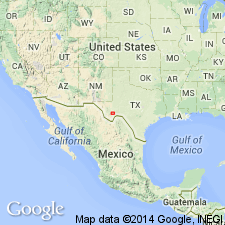
- Usage in publication:
-
- Bissett formation
- Modifications:
-
- Original reference
- Dominant lithology:
-
- Conglomerate
- Shale
- Limestone
- Dolomite
- AAPG geologic province:
-
- Permian basin
Summary:
Pg. 212-221. Bissett formation. Chiefly calcareous conglomerates derived from underlying beds. In upper part red shales alternate with conglomerate and in addition a few layers of limestone and dolomite appear. Locally red shales appear beneath the main conglomerate. Thickness 0 to 500 [720] feet. Underlies Comanche series with angular unconformity and overlaps undoubted marin Permian formations (Tessey, Gilliam, and upper part of Vidrio). On Bissett Mountain it rests on upper massive member of Vidrio formation. No fossils found. May be late Permian, Triassic, Jurassic, or early Cretaceous; most probably Permian or Triassic.
Named from exposures on northwest and northeast flanks of Bissett Mountain, southwest part of Glass Mountains, Brewster Co., western TX. Absent in northeast part of Glass Mountains.
Source: US geologic names lexicon (USGS Bull. 896, p. 195).
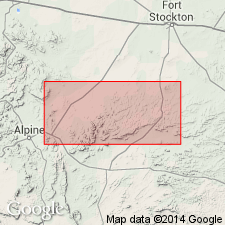
- Usage in publication:
-
- Bissett formation
- Modifications:
-
- Areal extent
- AAPG geologic province:
-
- Permian basin
Summary:
Pg. 84-89, pls. 13, 14, geol. map. Bissett formation. A conglomerate of rounded dolomite fragments derived from beds beneath, set in a calcareous matrix. Contains some interbedded layers of sandstone and limestone, and lenticular layers of red shale. Maximum thickness 720 feet. Underlies Comanche series with angular unconformity. Rests on Tessey member of Capitan formation east of Gilliland Canyon. Four miles east of Bissett Mountain it overlies a few hundred feet of thin-bedded strata at the top of "upper massive member" of Capitan, which is correlated with some part of Gilliam member of Capitan. Near Bissett Mountain it rests on a considerable thickness of "upper massive member," but four miles west of the mountain only 215 feet of this member intervene between the Bissett and the Altuda member of Capitan (pl. 14). This appears to represent a downward overlap across nearly 1,800 feet of strata in a distance of 17 miles, or an angular divergence of 100 feet per mile. Age is probably Late Permian, but may be Triassic. Footnote (p. 89): in Dec. 1930, fossil plants were obtained from the Bissett formation by E.H. Sellards, C.L. Baker, and M.B. Arick. These plants are regarded tentatively as Upper Permian by David White and by E.H. Sellards.
[See also entry under Capitan.]
Source: Publication; US geologic names lexicon (USGS Bull. 896, p. 195).
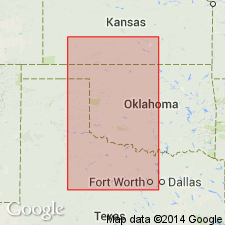
- Usage in publication:
-
- Bissett formation
- Modifications:
-
- Age modified
- AAPG geologic province:
-
- Permian basin
Summary:
Pg. 701. From field study believes Bissett formation at type locality of Bissett Mountain is of Comanche age. Is unconformable on Tessey, Gilliam, and Vidrio formations.
Source: US geologic names lexicon (USGS Bull. 896, p. 195).
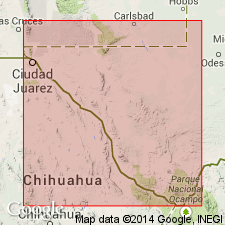
- Usage in publication:
-
- Bissett conglomerate*
- Modifications:
-
- Redescribed
- Age modified
- Dominant lithology:
-
- Conglomerate
- Sandstone
- Limestone
- Shale
- AAPG geologic province:
-
- Permian basin
Summary:
Pg. 738-739. Changed name to Bissett conglomerate (the formation consisting chiefly of conglomerate) and age to Permian(?).
Source: US geologic names lexicon (USGS Bull. 896, p. 195).

- Usage in publication:
-
- Bissett conglomerate*
- Modifications:
-
- Overview
- AAPG geologic province:
-
- Permian basin
Summary:
Present evidence favors early Triassic, rather than Permian, as age of Bissett conglomerate. Writer is now inclined to support Lang's (AAPG Bull., v. 19, no. 2, p. 270, 1935) suggestion that the Bissett is of pre-Dockum Triassic age.
[GNC remark (ca. 1936, US geologic names lexicon, USGS Bull. 896, p. 195): At present Triassic(?) is age classification of the USGS.]
Source: US geologic names lexicon (USGS Bull. 896, p. 195).
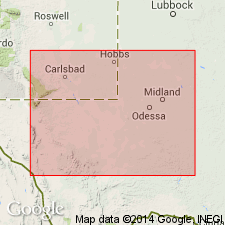
- Usage in publication:
-
- Bissett conglomerate*
- Modifications:
-
- Age modified
- AAPG geologic province:
-
- Permian basin
Summary:
Pg. 270. It is believed Bissett conglomerate represents an accumulation of lower Triassic sediments of possible Moenkopi time equivalence and therefore considerably older than the terrestrial Dockum and Santa Rosa deposits farther north.
Source: US geologic names lexicon (USGS Bull. 896, p. 195).
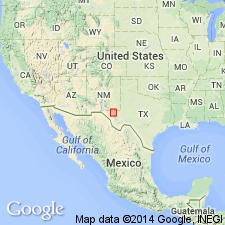
- Usage in publication:
-
- Bissett conglomerate*
- Modifications:
-
- Age modified
- AAPG geologic province:
-
- Permian basin
Summary:
Pg. 663. Bissett conglomerate, when first described, was considered to be of Permian age, but was shown to be separated from Permian limestones below and from the Cretaceous above by unconformities. Subsequent studies of vertebrates and plants from one locality in formation demonstrates that they are Triassic in age, and Bissett is now so classified. Some exposures to the northwest that have been mapped as Bissett may be much younger and belong to basal Cretaceous (Trinity).
Source: US geologic names lexicon (USGS Bull. 1200, p. 355).
For more information, please contact Nancy Stamm, Geologic Names Committee Secretary.
Asterisk (*) indicates published by U.S. Geological Survey authors.
"No current usage" (†) implies that a name has been abandoned or has fallen into disuse. Former usage and, if known, replacement name given in parentheses ( ).
Slash (/) indicates name conflicts with nomenclatural guidelines (CSN, 1933; ACSN, 1961, 1970; NACSN, 1983, 2005, 2021). May be explained within brackets ([ ]).

